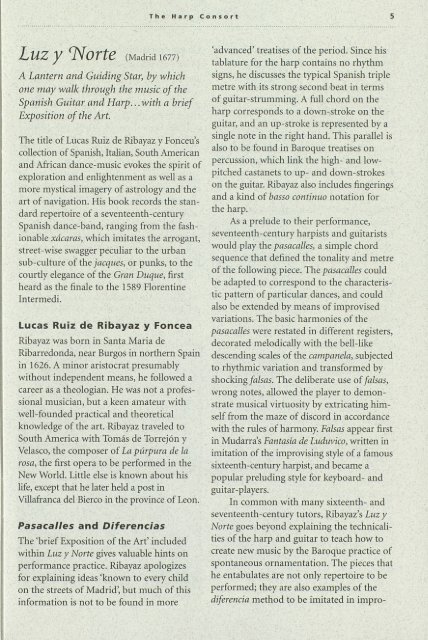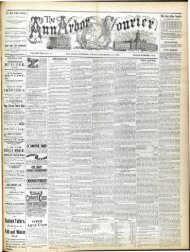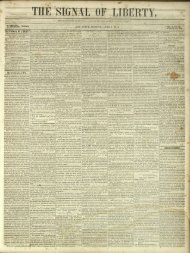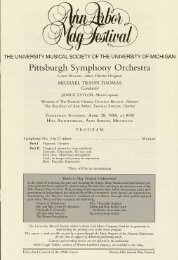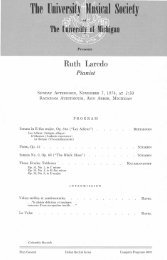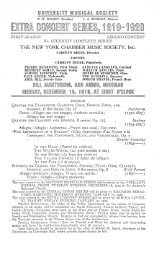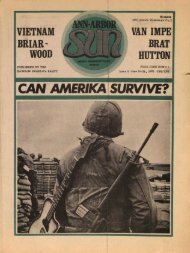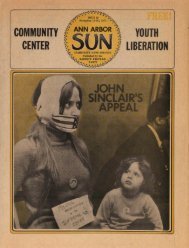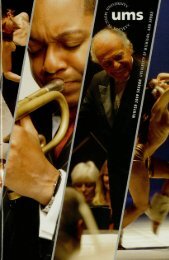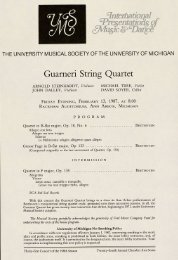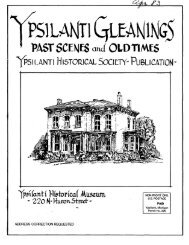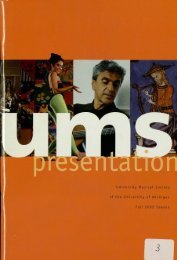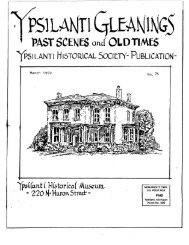Societyof the University of Michigan - Ann Arbor District Library
Societyof the University of Michigan - Ann Arbor District Library
Societyof the University of Michigan - Ann Arbor District Library
Create successful ePaper yourself
Turn your PDF publications into a flip-book with our unique Google optimized e-Paper software.
Luz y Worte (Madrid<br />
The Harp Consort<br />
A Lantern and Guiding Star, by which<br />
one may walk through <strong>the</strong> music <strong>of</strong> <strong>the</strong><br />
Spanish Guitar and Harp... with a brief<br />
Exposition <strong>of</strong> <strong>the</strong> Art.<br />
The title <strong>of</strong> Lucas Ruiz de Ribayaz y Fonceu's<br />
collection <strong>of</strong> Spanish, Italian, South American<br />
and African dance-music evokes <strong>the</strong> spirit <strong>of</strong><br />
exploration and enlightenment as well as a<br />
more mystical imagery <strong>of</strong> astrology and <strong>the</strong><br />
art <strong>of</strong> navigation. His book records <strong>the</strong> stan<br />
dard repertoire <strong>of</strong> a seventeenth-century<br />
Spanish dance-band, ranging from <strong>the</strong> fash<br />
ionable xdcaras, which imitates <strong>the</strong> arrogant,<br />
street-wise swagger peculiar to <strong>the</strong> urban<br />
sub-culture <strong>of</strong> <strong>the</strong> Jacques, or punks, to <strong>the</strong><br />
courtly elegance <strong>of</strong> <strong>the</strong> Gran Duque, first<br />
heard as <strong>the</strong> finale to <strong>the</strong> 1589 Florentine<br />
Intermedi.<br />
Lucas Ruiz de Ribayaz y Foncea<br />
Ribayaz was born in Santa Maria de<br />
Ribarredonda, near Burgos in nor<strong>the</strong>rn Spain<br />
in 1626. A minor aristocrat presumably<br />
without independent means, he followed a<br />
career as a <strong>the</strong>ologian. He was not a pr<strong>of</strong>es<br />
sional musician, but a keen amateur with<br />
well-founded practical and <strong>the</strong>oretical<br />
knowledge <strong>of</strong> <strong>the</strong> art. Ribayaz traveled to<br />
South America with Tomas de Torrejon y<br />
Velasco, <strong>the</strong> composer <strong>of</strong> La purpura de la<br />
rosa, <strong>the</strong> first opera to be performed in <strong>the</strong><br />
New World. Little else is known about his<br />
life, except that he later held a post in<br />
Villafranca del Bierco in <strong>the</strong> province <strong>of</strong> Leon.<br />
Pasacalles and D/ferenc/as<br />
The 'brief Exposition <strong>of</strong> <strong>the</strong> Art' included<br />
within Luz y Norte gives valuable hints on<br />
performance practice. Ribayaz apologizes<br />
for explaining ideas 'known to every child<br />
on <strong>the</strong> streets <strong>of</strong> Madrid', but much <strong>of</strong> this<br />
information is not to be found in more<br />
'advanced' treatises <strong>of</strong> <strong>the</strong> period. Since his<br />
tablature for <strong>the</strong> harp contains no rhythm<br />
signs, he discusses <strong>the</strong> typical Spanish triple<br />
metre with its strong second beat in terms<br />
<strong>of</strong> guitar-strumming. A full chord on <strong>the</strong><br />
harp corresponds to a down-stroke on <strong>the</strong><br />
guitar, and an up-stroke is represented by a<br />
single note in <strong>the</strong> right hand. This parallel is<br />
also to be found in Baroque treatises on<br />
percussion, which link <strong>the</strong> high- and low-<br />
pitched castanets to up- and down-strokes<br />
on <strong>the</strong> guitar. Ribayaz also includes fingerings<br />
and a kind <strong>of</strong> basso continue notation for<br />
<strong>the</strong> harp.<br />
As a prelude to <strong>the</strong>ir performance,<br />
seventeenth-century harpists and guitarists<br />
would play <strong>the</strong> pasacalles, a simple chord<br />
sequence that defined <strong>the</strong> tonality and metre<br />
<strong>of</strong> <strong>the</strong> following piece. The pasacalles could<br />
be adapted to correspond to <strong>the</strong> characteris<br />
tic pattern <strong>of</strong> particular dances, and could<br />
also be extended by means <strong>of</strong> improvised<br />
variations. The basic harmonies <strong>of</strong> <strong>the</strong><br />
pasacalles were restated in different registers,<br />
decorated melodically with <strong>the</strong> bell-like<br />
descending scales <strong>of</strong> <strong>the</strong> campanela, subjected<br />
to rhythmic variation and transformed by<br />
shocking/a/sfls. The deliberate use <strong>of</strong>falsas,<br />
wrong notes, allowed <strong>the</strong> player to demon<br />
strate musical virtuosity by extricating him<br />
self from <strong>the</strong> maze <strong>of</strong> discord in accordance<br />
with <strong>the</strong> rules <strong>of</strong> harmony. Falsas appear first<br />
in Mudarra's Fantasia de Luduvico, written in<br />
imitation <strong>of</strong> <strong>the</strong> improvising style <strong>of</strong> a famous<br />
sixteenth-century harpist, and became a<br />
popular preluding style for keyboard- and<br />
guitar-players.<br />
In common with many sixteenth- and<br />
seventeenth-century tutors, Ribayaz's Luz y<br />
Norte goes beyond explaining <strong>the</strong> technicali<br />
ties <strong>of</strong> <strong>the</strong> harp and guitar to teach how to<br />
create new music by <strong>the</strong> Baroque practice <strong>of</strong><br />
spontaneous ornamentation. The pieces that<br />
he entabulates are not only repertoire to be<br />
performed; <strong>the</strong>y are also examples <strong>of</strong> <strong>the</strong><br />
diferencia method to be imitated in impro-


